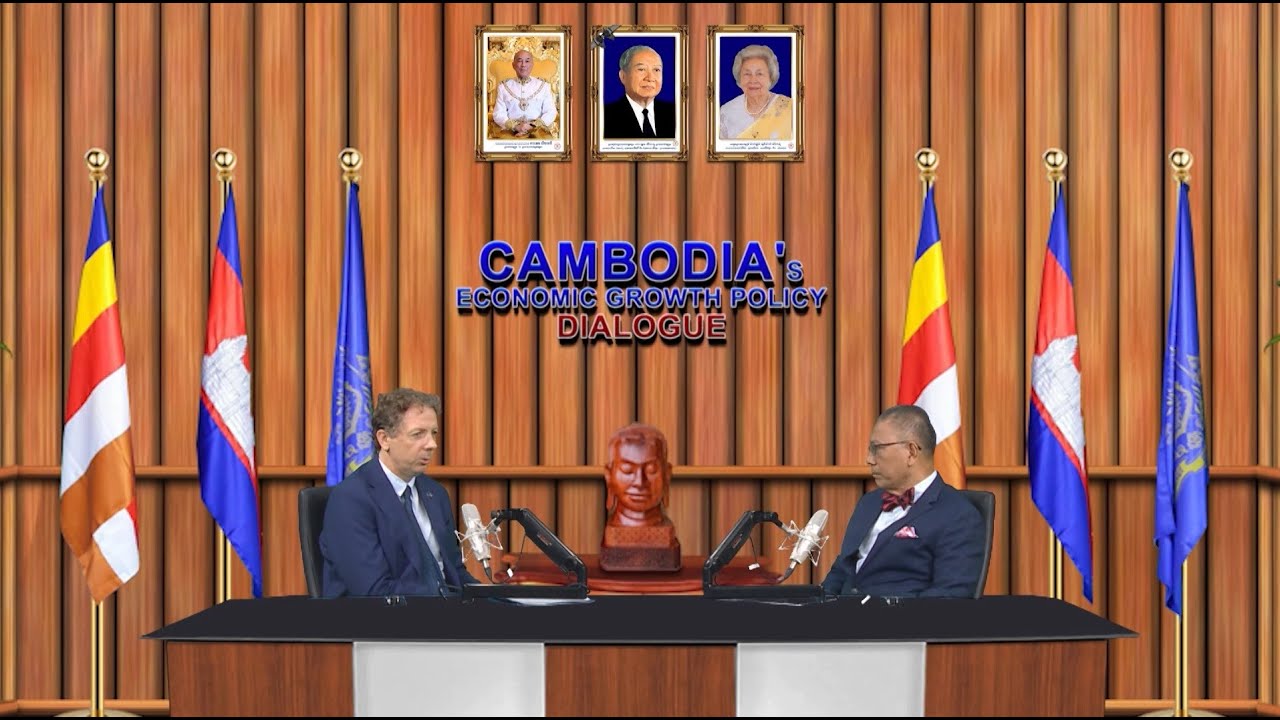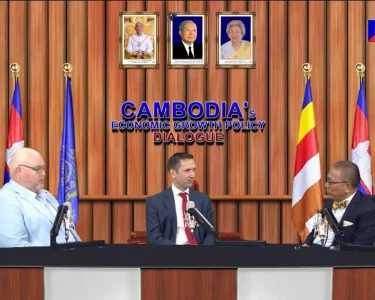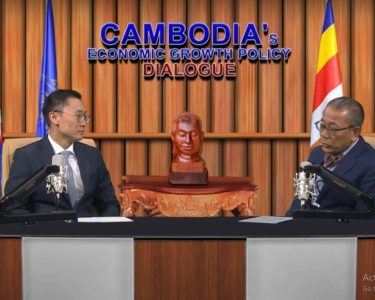Cambodia Investment Review
Cambodia’s Economic Growth Policy Dialogue, moderated by Senior Minister in charge of Special Missions (Multilateral Trade and Economic Affairs) and Chairman of the Trade Policy Advisory Board Dr. Sok Siphana, featured a wide-ranging discussion with the European Union’s Ambassador to Cambodia, Igor Driesmans, covering trade, agriculture, education, and climate change as the Kingdom prepares for its transition to middle-income status by 2029.
Dr. Siphana noted that the EU’s presence has been instrumental in Cambodia’s development journey, citing the bloc’s contributions not only to economic growth but also to social programs, fisheries, and education. Ambassador Driesmans emphasized that EU cooperation stretches back more than 30 years, beginning with humanitarian relief and demining projects after the fall of the Khmer Rouge and steadily expanding into today’s comprehensive partnership.
Trade and Market Access
Cambodia’s trade relationship with the EU remains one of its strongest economic drivers. Exports to the EU totaled around USD 7 billion last year, cementing the bloc as Cambodia’s second-largest export destination after the United States.
Ambassador Driesmans highlighted the importance of the Everything But Arms (EBA) initiative, which provides duty-free and quota-free access for all Cambodian exports except arms and ammunition. The scheme has enabled the Kingdom’s garment and footwear sector to thrive, alongside newer export categories like bicycles, travel goods, and solar panels.
However, Cambodia’s upcoming graduation from least-developed country (LDC) status in 2029 will alter this dynamic. Current rules require only a single transformation—such as fabric imported from abroad being stitched into garments in Cambodia. After graduation, the EU will require a double transformation, such as local weaving or fabric production, to qualify for tariff exemptions.
To make this clearer:
- The EU buys over USD 7 billion in Cambodian exports annually.
- Garments still account for nearly half of shipments, but diversification is growing.
- LDC graduation in 2029 means new tariff rules and tougher origin requirements.
- Manufacturers will need to invest in local value-add capacity to stay competitive.
Dr. Siphana framed this as both a challenge and a source of pride. “In less than one generation, Cambodia has emerged from poverty to become a developing country,” he said. “Yes, we will lose some preferences, but the psychological shift is important—we now must compete, sharpen competitiveness, and diversify.”
Cashew and Agriculture Value-Addition
Agriculture is another area where Cambodia and the EU see opportunities for greater value capture. Cashew production is booming, with around 800,000 metric tons harvested annually. Yet, 97% of that output is exported raw and processed abroad, particularly in Vietnam, before reaching European or U.S. markets.
Read More: EU Backs €3.5M Drive to Close Cambodia’s Budget Transparency Gap
Ambassador Driesmans pointed out that if even 70% of cashews were processed locally, it could add USD 2 billion to Cambodia’s GDP. The EU has already partnered with the Ministry of Agriculture to train 6,000 farmers in better drying and sorting techniques, while also working to expand access to financing so farmers are not forced into short-term sales.
Dr. Siphana emphasized that cashew is not just about food exports but also innovation and industrial applications. He cited examples ranging from cashew-based spirits such as gin and brandy to industrial paint and biochar technologies that could generate carbon credits. “The critical mass is here,” he said. “The challenge is how to build the value-add capacity around it.”
Education and Scholarships
Education was highlighted as the foundation for long-term competitiveness. Ambassador Driesmans noted that Cambodia’s education system suffered deep setbacks during the Khmer Rouge era, leaving the country to rebuild its human capital almost from scratch.
Over the past two decades, the EU has supported Cambodia’s education reforms, starting with primary education and now shifting toward technical and higher education. The EU recently announced 500 new scholarships for Cambodian students in STEM fields—science, technology, engineering, and mathematics—alongside specialized programs in energy, water, and fisheries. A Study in Europe Fair is planned for November to showcase these opportunities.
Currently, only about 70 Cambodians study in Europe annually through Erasmus+, which Driesmans said is “far too low.” By expanding opportunities, the EU hopes to increase exposure to European universities and build a stronger pool of skilled graduates returning to Cambodia.
To break it down:
- EU has invested in primary, technical, and tertiary education in Cambodia.
- 500 new scholarships will be offered in STEM fields.
- Current Erasmus+ participation is around 70 Cambodian students per year.
- The Study in Europe Fair on November 14 aims to raise awareness.
Dr. Siphana praised the initiative, stressing that scholarships transform not only individual lives but entire communities. “If 500 students return each year well-educated, they bring knowledge back to Phnom Penh and the provinces. That is powerful for Cambodia’s future,” he said.
Climate and Renewable Energy
Both speakers also addressed the green transition. Cambodia has committed to sourcing 70% of its energy from renewable sources by 2030, a goal Ambassador Driesmans described as “bold and courageous.”
He noted that European buyers, from Adidas to Zara, increasingly require renewable energy in their supply chains. Japanese electronics manufacturer Minebea, which has operated in Cambodia for a decade, recently expanded into Pursat specifically to access renewable power sources.
Beyond energy, compliance with EU standards on sustainability is becoming more critical. Driesmans outlined three major areas:
- Sanitary standards: ensuring agricultural exports like rice meet EU pesticide limits.
- Renewable sourcing: meeting private sector demands for clean energy in production.
- Deforestation rules: ensuring products like rubber are not linked to deforested land.
Dr. Siphana added that clear guidance for farmers and exporters is essential, pointing to recent cases where European buyers offered Cambodian factories direct compliance roadmaps. “It’s one thing to talk about standards, but another to know exactly what needs to be done,” he said.
Multilateralism and Global Cooperation
The dialogue also touched on geopolitics and multilateralism. Both speakers reaffirmed their support for the World Trade Organization (WTO), noting that while reforms are necessary, the institution remains vital for smaller economies like Cambodia.
Dr. Siphana stressed that multilateralism safeguards Cambodia from the pressures of larger powers. He also highlighted Cambodia’s role as a host for major international gatherings, including the Francophonie Summit scheduled for 2026 in Siem Reap, which is expected to bring over 90 delegations.
Ambassador Driesmans added that preserving international rules-based systems is critical for managing disputes, from maritime conflicts to climate agreements. “Without rules, we only have the law of the jungle,” he warned.
Looking Ahead
Wrapping up the dialogue, Dr. Siphana directed his message to Cambodia’s youth. He urged students to improve their English, pursue opportunities abroad, and focus on building competitive skills for the economy of the future.
“Cambodia must move up the value chain—whether in garments, cashews, or electric vehicles,” he said. “The younger generation has a role to play, and education is the key to that transformation.”





